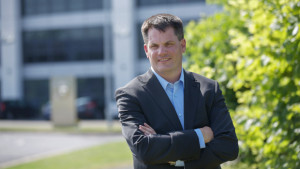
Predictions 2015
Longform
(Image: Stockfresh)
We all like to have some idea of what is coming down the line, whether it is to help with planning and decision making or just to know that we have made proper preparations.
TechPro has assembled its widest range yet of experts, from vendors, service providers, integrators and partners, to bring the IT professional the most comprehensive outline yet of what to expect from the year ahead.
The topics covered include the macro trends from big data, analytics, mobility and security, down to software defined everything, unified communications and collaborative tools.
We hope that with this broad range of insights and predictions, you will be better prepared to meet the challenges that lie ahead and ensure that your organisation stays ahead of the curve.
| Power efficiency priority |
| “IT will be required to deliver new information systems delivering insight and business intelligence, which in turn will mean increasing use of the cloud as a delivery mechanism for rapid deployment of business-critical applications at predictable cost” |

Schneider Electric : Vincent Barro, vice president, Schneider Electric IT Ireland |
|
The recovery in the Irish economy, already measurably under way, will continue in 2015 bringing with it increased demand for IT infrastructure services. In line with predicted international trends, much of this demand will be realised by equipment co-located in third-party data centres or through services delivered via the cloud.
IDC predicts that by 2016 more than 50% of raw compute capacity and 70% of raw storage capacity worldwide will be hosted in hyper-scale data centres. It also predicts that by the following year, 60% of the data-centre based IT assets on which organisations rely will be on colocation, hosting and cloud data centres.
These forecasts reflect a trend that has been gathering momentum for some time, and will continue throughout 2015, of smaller clients on people’s desks and even smaller servers in their companies’ own server rooms. Connectivity and reliable service delivery from third-party infrastructure providers will be the vital elements.To provide their organisations with the agility to thrive in growing markets, IT will be required to deliver new information systems delivering insight and business intelligence, which in turn will mean increasing use of the cloud as a delivery mechanism for rapid deployment of business-critical applications at predictable cost. IDC also predicts that the next two years will witness a crunch between immature or incompatible IT assets in existing organisations’ own facilities preventing organisations from taking full advantage of the potential of new software. This will be a widespread phenomenon, experienced by as much as 80% of all organisations.
And as if such pressures from above were not enough to continue driving IT decision makers towards increasing use of cloud deployments, there is the inevitable push from below as individuals increasingly adopt simple, low-cost cloud-based services for file sharing and remote access, with all the attendant security and confidentiality threats this entails. Increasing the use of managed systematic cloud services into more and more areas of the company will be an inevitable solution.For companies supplying these ever bigger and more numerous data centres the future is promising, if challenging. Another IDC prediction is that many medium to large-sized organisations will confront significant power and cooling facilities mismatches with new IT systems which will limit them to using less than 75% of their physical data-centre space. The implication is clear: improvements in data-centre design and more efficient use of power to drive both the IT systems and the equipment needed to cool them will become priorities.
The recent slump in the price of oil may offset some of the short-term financial concerns around energy production but ongoing environmental concerns and Corporate Sustainability Report audits will continue to apply pressure on IT providers to maximise power efficiency. Furthermore, depending on an industry as capricious as oil production to ensure low energy costs in the long term is unwise. Maximising energy efficiency will always be a smart priority.
|
| Don’t get locked in! |
| “Many organisations are aware of the potential impact of virtualisation on the network but they are not yet ready to embrace it” |
 Agile Networks : Darragh Richardson, managing director Agile Networks : Darragh Richardson, managing director |
| One thing is certain in 2015 — nobody really knows where the network is going to evolve to.To Virtualise or Not Virtualise? The server and storage markets are clearly moving at pace into a virtualised world. The standards are maturing and most end users know which technology vendors they want to back. Networking is different. As we found out at Techfire 13 in November, many organisations are aware of the potential impact of virtualisation on the network but they are not yet ready to embrace it — in particular the potential impact SDN will make. Maybe 2015 will be the year that SDN finally takes off, but there is a good chance many people will take a wait and see approach.
Even Gartner don’t know: The striking point in Gartner’s latest Data Centre Network Magic Quadrant is that there is nobody in the ‘Leader’ quadrant. Not only that but it features software companies like VMWare competing with established players like HP, Cisco, and Juniper Networks. The overall impression is clear — change will happen but we don’t know who the winners will be. Therefore we don’t entirely know what the right network will be — but we do know what the wrong network will be. The typical refresh cycle for networks is 5-7 years. But given the current, flux what platform should you build to ‘keep the lights on’ in 2015 without committing to a network that won’t flex into the future?
Don’t fall for vendor lock-in: The reality is we are a year or two away from standards, practices, and vendors agreeing what SDN will really look like and how it will interoperate. In the meantime if a vendor can lock you into their network, especially in the core, then it restricts your options in future. So your New Year’s resolution should be simple — invest in the right technology to keep your options open in the future. As a simple example, consider fixed form factor devices instead of expensive chassis based switches for your data centre.
These are easier to change in the future, potentially reusing some core devices today in different parts of the network tomorrow. The bottom line is keep your options open and design a network which is open, agile, and capable of changing over the next three years.Right size networks wrong sized partners: The recent economic upswing is allowing companies to reinvest in their network, often for the first time in many years. There is pent up demand and some temptation to rip and replace as vendors look to coax you into forklift upgrades. But ask yourself a simple question: what does the business actually need and what will change in the next 18 months?
Getting a right size network means working with a vendor, or vendors, who will give you options, protect your legacy investments, and maintain your flexibility. Remember when nobody ever got fired for buying IBM? Well just as the mainframe was replaced by the PC, networks are about to change and we simply don’t know who the winners and losers will be. So my prediction for 2015 is that it will be more important than ever that you have a partner who can help you build the right network customised to your business rather than a “one size fits all” approach.
|
| Change management challenge |
| “What do you need to do to gain access to the skills you need while protecting your investment?” |

SureSkills : Kevin Reid, chief technical officer |
| After more than half a decade of tough times, it is heartening to see the economy moving back on the right path. Businesses are increasingly in a position to invest in new systems or to upgrade those that have exceeded their useful life and, equally important, to plan for their next generation of ICT. As a result, there are lots of predictions around this time of the year that 2015 will be ‘The Year of X’, whatever X might be. There are certainly plenty of candidates for hype.
But in truth that’s all fairly superficial. This increased activity that the industry anticipates, brings with it a more fundamental challenge — access to the necessary skills and experience. Another factor to be considered is the relative scarcity and increasing expense of those skills. Acquiring them or upskilling existing staff also raises other questions in an IT labour market that is becoming fluid again.So the 2015 question for business ICT is what do you need to do to gain access to the skills you need while protecting your investment? The answer, or at least one effective answer, is a limited form of outsourcing. Most organisations do not want to hand over everything. That is not necessarily just being conservative; after all there is much truth in that old outsourcing mantra ‘do what you do best…’
Instead, you need to focus on the bits that could be effectively moved to an external service provider. You also need to look hard at those technical skills that are essentially ‘one-off’ rather than an ongoing requirement. The obvious example is upgrading core systems and infrastructure, while there will be skills and experience needed for projects that will be redundant after completion.
There are three things that we now focus on in this whole area, ‘pillars of change’, as we call them. The first is straightforward, executing the change, whether they are new systems or upgrades. Typically, it is outsourced to experts in the relevant fields, in part because internal IT is traditionally focussed on sustainment.
The second piece is transition planning, which is a combination of a range of elements, such as defining SLAs and ensuring that you have a competency map for your own IT staff into the future. That is extremely important, all the way down to individual training and certification, because that is what will support your IT future.The final part is where you take all of the transition information and deliver it to the support function. That could be internal or a managed service with the key element being that it is handed over appropriately and professionally.
There are many drivers for all of this in 2015. Microsoft end-of-life for Server 2003 is going to feature strongly, but so will the question of what might be moved to the cloud with demonstrable business benefit — and indeed what form of cloud? But a successful outcome to all those decisions will rest on the platforms of effective change management and the skills to sustain the ICT investment into the future.The specific technologies are each important, of course, but having coped with rolling technology changes in ICT for generations we know they are not fundamental. The challenge in 2015 is likely to be the surge of change and the ability to manage it in an optimum manner, in a highly dynamic ICT environment that places an increasing premium on appropriate skills.
|
Pages: 1 2 3 4 5 6 7 8 9 10
Read More: 2015 longform predictions










Subscribers 0
Fans 0
Followers 0
Followers